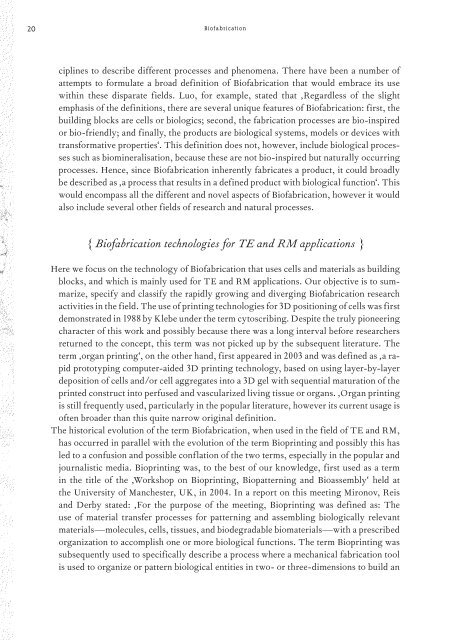Logbuch_17x24Druck_einzelseiten
You also want an ePaper? Increase the reach of your titles
YUMPU automatically turns print PDFs into web optimized ePapers that Google loves.
20<br />
Biofabrication<br />
ciplines to describe different processes and phenomena. There have been a number of<br />
attempts to formulate a broad definition of Biofabrication that would embrace its use<br />
within these disparate fields. Luo, for example, stated that ‚Regardless of the slight<br />
emphasis of the definitions, there are several unique features of Biofabrication: first, the<br />
building blocks are cells or biologics; second, the fabrication processes are bio-inspired<br />
or bio-friendly; and finally, the products are biological systems, models or devices with<br />
transformative properties‘. This definition does not, however, include biological processes<br />
such as biomineralisation, because these are not bio-inspired but naturally occurring<br />
processes. Hence, since Biofabrication inherently fabricates a product, it could broadly<br />
be described as ‚a process that results in a defined product with biological function‘. This<br />
would encompass all the different and novel aspects of Biofabrication, however it would<br />
also include several other fields of research and natural processes.<br />
{ Biofabrication technologies for TE and RM applications }<br />
Here we focus on the technology of Biofabrication that uses cells and materials as building<br />
blocks, and which is mainly used for TE and RM applications. Our objective is to summarize,<br />
specify and classify the rapidly growing and diverging Biofabrication research<br />
activities in the field. The use of printing technologies for 3D positioning of cells was first<br />
demonstrated in 1988 by Klebe under the term cytoscribing. Despite the truly pioneering<br />
character of this work and possibly because there was a long interval before researchers<br />
returned to the concept, this term was not picked up by the subsequent literature. The<br />
term ‚organ printing‘, on the other hand, first appeared in 2003 and was defined as ‚a rapid<br />
prototyping computer-aided 3D printing technology, based on using layer-by-layer<br />
deposition of cells and/or cell aggregates into a 3D gel with sequential maturation of the<br />
printed construct into perfused and vascularized living tissue or organs. ‚Organ printing<br />
is still frequently used, particularly in the popular literature, however its current usage is<br />
often broader than this quite narrow original definition.<br />
The historical evolution of the term Biofabrication, when used in the field of TE and RM,<br />
has occurred in parallel with the evolution of the term Bioprinting and possibly this has<br />
led to a confusion and possible conflation of the two terms, especially in the popular and<br />
journalistic media. Bioprinting was, to the best of our knowledge, first used as a term<br />
in the title of the ‚Workshop on Bioprinting, Biopatterning and Bioassembly‘ held at<br />
the University of Manchester, UK, in 2004. In a report on this meeting Mironov, Reis<br />
and Derby stated: ‚For the purpose of the meeting, Bioprinting was defined as: The<br />
use of material transfer processes for patterning and assembling biologically relevant<br />
materials—molecules, cells, tissues, and biodegradable biomaterials—with a prescribed<br />
organization to accomplish one or more biological functions. The term Bioprinting was<br />
subsequently used to specifically describe a process where a mechanical fabrication tool<br />
is used to organize or pattern biological entities in two- or three-dimensions to build an


